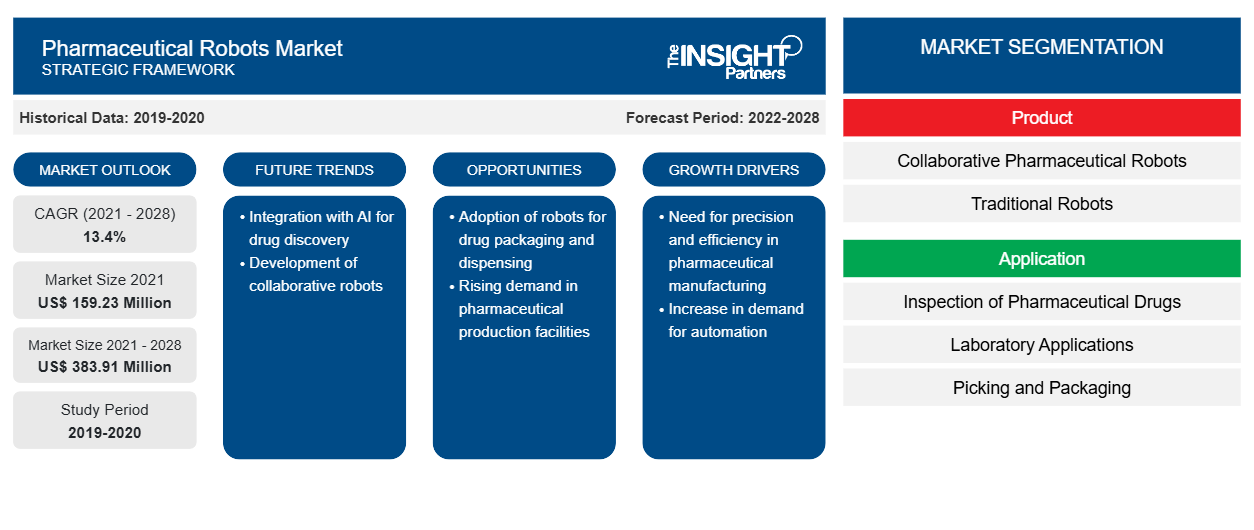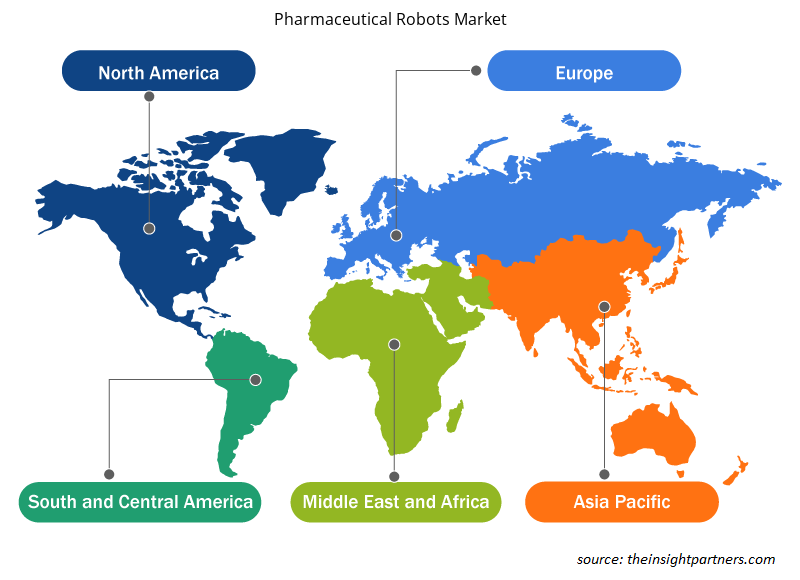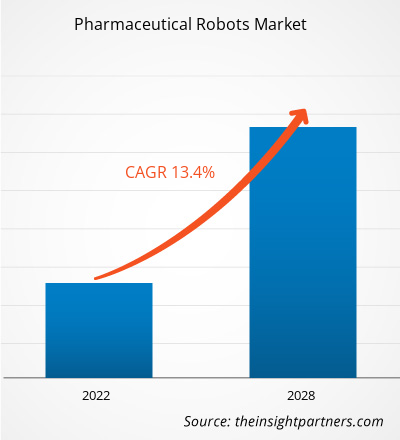[Research Report] The pharmaceutical robots market is projected to reach US$ 383.91 million by 2028 from US$ 159.23 million in 2021; it is expected to grow at a CAGR of 13.4% from 2021 to 2028.
Pharmaceutical industry requires efficient and precise precision in production of pharmaceutical drugs. Thus, using robots in pharmaceutical manufacturing improves quality and reduces cost and time. Robots are proving advantageous in filling, inspection, packaging, laboratories, and the manufacture of personalized medicine. A robotic system is a type of automation that has multiple axes of motion and can be programmed to perform any function.
The report offers insights and in-depth analysis of the pharmaceutical robots market emphasizing on various parameters such as market trends, technological advancements, market dynamics, and competitive landscape analysis of leading market players across the world. It also includes the impact of the COVID-19 pandemic on the market across all the regions. The impact of the pandemic and decreasing global research activities have also harmed the operations and financial execution of several companies in the pharmaceutical robots market. The OIE, the World Organization for Animal Health aids research for their on-going research and other implications of COVID-19 for animal health and poultry public health. The organization also helps in risk assessment, risk management, and risk communication. The OIE has deployed an Incident Coordination System to coordinate these activities. Moreover, the COVID-19 pandemic and consequent lockdown impositions have significantly impacted the livestock and poultry sectors in different countries in the world. The demand–supply gap is found to decrease gradually with the opening-up of market chains and additional steps taken by the local administrations in plugging the bottlenecks in delivery systems. It is further envisaged that the impact would continue to be long-standing and will have great bearing on the livelihood, employment, and overall economy of the sector. The pharmaceutical robots market is segmented on the bases of dosage, disease, technology, and region. The market, based on region, is segmented into North America, Europe, Asia Pacific, Middle East and Africa, and South and Central America.
Market Insights
Customize This Report To Suit Your Requirement
You will get customization on any report - free of charge - including parts of this report, or country-level analysis, Excel Data pack, as well as avail great offers and discounts for start-ups & universities
Pharmaceutical Robots Market: Strategic Insights

- Get Top Key Market Trends of this report.This FREE sample will include data analysis, ranging from market trends to estimates and forecasts.
Customize This Report To Suit Your Requirement
You will get customization on any report - free of charge - including parts of this report, or country-level analysis, Excel Data pack, as well as avail great offers and discounts for start-ups & universities
Pharmaceutical Robots Market: Strategic Insights

- Get Top Key Market Trends of this report.This FREE sample will include data analysis, ranging from market trends to estimates and forecasts.
Rising Trend of Cloud Robotic
Cloud robotics is an emerging field of robotics rooted in cloud computing, cloud storage, and other Internet technologies centered on the benefits of converged infrastructure and shared services. Connecting robots to the cloud increase computational power, storage, and communications. Cloud robots communicate with each other and thus operations are carried out easily.
The Google Cloud Robotics Platform combines AI, robotics, and the cloud to enable the opening of an ecosystem of automation solutions that use cloud-connected collaborative robots. Along with AI and machine learning services, the robots will be able to efficiently carry out processes in highly dynamic environments in the manufacturing industry. Moreover, in the industry, the cloud is an ally for processing a large amount of data. For instance, Exscientia and Celgene, a biopharmaceutical company, announced a €19.64 million deal in 2019 to speed up the discovery of medications for cancer and autoimmune illnesses. In 2020, it also announced a collaboration with other firms to find possible COVID-19 medications. As a result, the company now has access to a package of molecules, including medications and other chemicals, that have been successfully tested in humans. The company intended to scan the list for any medications that could be able to combat the virus. Exscientia's technology scans the large databases and can accurately predict which compounds do not generate side effects to reach the desired goal. Similarly, in 2020, another pharmaceutical company, Boehringer Ingelheim, partnered with a biotech company, Click Therapeutics, to produce $500 million in digital treatments. More precisely, both firms planned to collaborate on the development and distribution of a mobile application to help schizophrenia patients with cognitive deficiencies. Also, IBM has created RoboRXN, a chemical laboratory that uses AI, cloud computing, and robotics to develop drugs from the researchers' own homes.
Cloud-based software, with appropriate security protocols, can be adopted to facilitate integration and automation. Its use helps reduce the paperwork of the companies, making data manageable. Thus, cloud robotics is expected to become the trend in the pharmaceutical robot market in the future.
Product -Based Insights
Based on product, the pharmaceutical robots market is segmented into collaborative pharmaceutical robots, and traditional robots. In 2021, collaborative pharmaceutical robots segment is estimated to account for the largest market share, whereas traditional robots is expected to witness the highest CAGR in the market during the forecast period. The growth of this segment is attributed to the increase in the use of robots in dispensing, sorting, kit assembly, and light machine-tending as well as in more traditional applications associated with packaging and others.
Application-Based Insights
Based on application, the pharmaceutical robots market is segmented into inspection of pharmaceutical drugs, laboratory applications, and picking and packaging. The inspection of pharmaceutical drugs segment would hold the largest share of the market in 2021 and is estimated to register the highest CAGR in the market during the forecast period.
End-User-Based Insights
Based on end user, the pharmaceutical robots market is segmented into pharmaceutical companies, research laboratories, and contract research organizations. The pharmaceutical companies segment would hold the largest share of the market in 2021, whereas the research laboratories segment is estimated to register the highest CAGR in the market during the forecast period
The pharmaceutical robots market players adopt organic strategies such as product launch and expansion to expand their footprint and product portfolio worldwide as well as to meet the growing demand.
Pharmaceutical Robots Market Regional Insights
The regional trends and factors influencing the Pharmaceutical Robots Market throughout the forecast period have been thoroughly explained by the analysts at Insight Partners. This section also discusses Pharmaceutical Robots Market segments and geography across North America, Europe, Asia Pacific, Middle East and Africa, and South and Central America.

- Get the Regional Specific Data for Pharmaceutical Robots Market
Pharmaceutical Robots Market Report Scope
| Report Attribute | Details |
|---|---|
| Market size in 2021 | US$ 159.23 Million |
| Market Size by 2028 | US$ 383.91 Million |
| Global CAGR (2021 - 2028) | 13.4% |
| Historical Data | 2019-2020 |
| Forecast period | 2022-2028 |
| Segments Covered |
By Product
|
| Regions and Countries Covered | North America
|
| Market leaders and key company profiles |
Pharmaceutical Robots Market Players Density: Understanding Its Impact on Business Dynamics
The Pharmaceutical Robots Market market is growing rapidly, driven by increasing end-user demand due to factors such as evolving consumer preferences, technological advancements, and greater awareness of the product's benefits. As demand rises, businesses are expanding their offerings, innovating to meet consumer needs, and capitalizing on emerging trends, which further fuels market growth.
Market players density refers to the distribution of firms or companies operating within a particular market or industry. It indicates how many competitors (market players) are present in a given market space relative to its size or total market value.
Major Companies operating in the Pharmaceutical Robots Market are:
- ABB Ltd.
- Kawasaki Heavy Industries, Ltd.
- Yaskawa Electric Corporation
- Universal Robots A/S
- Marchesini Group S.p.A
Disclaimer: The companies listed above are not ranked in any particular order.

- Get the Pharmaceutical Robots Market top key players overview
By Product
- Collaborative Pharmaceutical Robots
- Traditional Robots
- Delta Robots
- Articulated Robots
- Cartesian Robots
- SCARA Robots
- Others
By Application
- Inspection of Pharmaceutical Drugs
- Laboratory Applications
- Picking and Packaging
By End User
- Pharmaceutical Companies
- Research Laboratories
- Contract Research Organizations
By
Geography
North America
- US
- Canada
- Mexico
Europe
- France
- Germany
- Italy
- UK
- Spain
- Rest of Europe
Asia Pacific (APAC)
- China
- India
- South Korea
- Japan
- Australia
- Rest of APAC
Middle East & Africa (MEA)
- South Africa
- Saudi Arabia
- UAE
- Rest of MEA
South and Central America (SCAM)
- Brazil
- Argentina
- Rest of SCAM
Company Profiles
- ABB Ltd.
- Kawasaki Heavy Industries, Ltd.
- Yaskawa Electric Corporation
- Universal Robots A/S
- Marchesini Group S.p.A
- Denso Corporation
- Fanuc Corporation
- Espon India Pvt. Ltd.
- Shibuya Corporation
- Weiss GmbH
- Historical Analysis (2 Years), Base Year, Forecast (7 Years) with CAGR
- PEST and SWOT Analysis
- Market Size Value / Volume - Global, Regional, Country
- Industry and Competitive Landscape
- Excel Dataset


- Neurovascular Devices Market
- Resistance Bands Market
- Energy Recovery Ventilator Market
- Passport Reader Market
- Vertical Farming Crops Market
- Biopharmaceutical Tubing Market
- Arterial Blood Gas Kits Market
- Electronic Toll Collection System Market
- Adaptive Traffic Control System Market
- Ceiling Fans Market

Report Coverage
Revenue forecast, Company Analysis, Industry landscape, Growth factors, and Trends

Segment Covered
Product ; Application ; End User ; and Geography

Regional Scope
North America, Europe, Asia Pacific, Middle East & Africa, South & Central America

Country Scope
Argentina, Australia, Brazil, Canada, China, France, Germany, India, Italy, Japan, Mexico, Saudi Arabia, South Africa, South Korea, Spain, United Arab Emirates, United Kingdom, United States
Frequently Asked Questions
The growth of the market is attributed to benefits offered by robots in pharmaceutical manufacturing, growing awareness of robotic systems in manufacturing process, increasing investments in pharmaceutical research and development. However, the high cost of robots and dearth of skilled professional hinder the market growth.
The types of pharmaceutical robots are collaborative pharmaceutical robots, and traditional robots. The traditional robots are segmented into delta robots, articulated robots, cartesian robots, scara robots, and others.
Pharmaceutical industry requires efficient and precise precision in production of pharmaceutical drugs. Thus, using robots in pharmaceutical manufacturing improves quality and reduces cost and time. Robots are proving advantageous in filling, inspection, packaging, laboratories, and the manufacture of personalized medicine. A robotic system is a type of automation that has multiple axes of motion and can be programmed to perform any function.Pharmaceutical industry requires efficient and precise precision in production of pharmaceutical drugs. Thus, using robots in pharmaceutical manufacturing improves quality and reduces cost and time. Robots are proving advantageous in filling, inspection, packaging, laboratories, and the manufacture of personalized medicine. A robotic system is a type of automation that has multiple axes of motion and can be programmed to perform any function.
Trends and growth analysis reports related to Life Sciences : READ MORE..
The List of Companies - Pharmaceutical Robots Market
- ABB Ltd.
- Kawasaki Heavy Industries, Ltd.
- Yaskawa Electric Corporation
- Universal Robots A/S
- Marchesini Group S.p.A
- Denso Corporation
- Fanuc Corporation
- Espon India Pvt. Ltd.
- Shibuya Corporation
- Weiss GmbH

 Get Free Sample For
Get Free Sample For